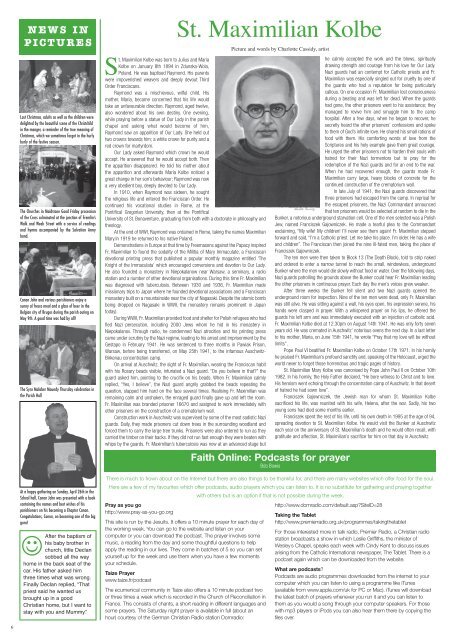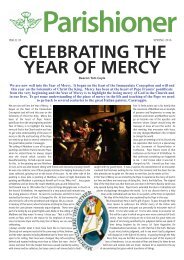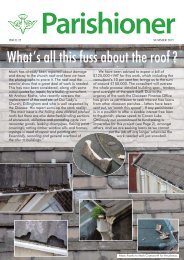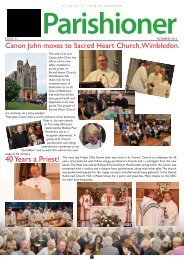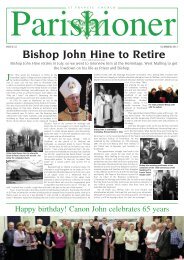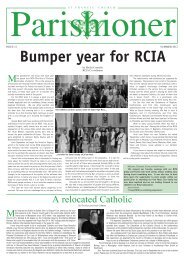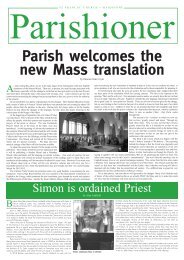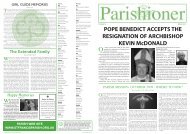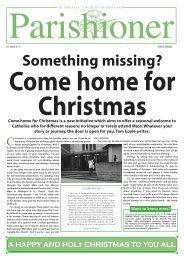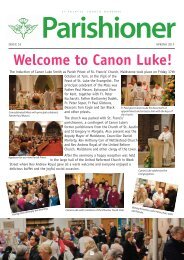The Parishioner - Edition 17
The Parishioner is the quarterly publication of St. Francis' Catholic Parish, Maidstone.
The Parishioner is the quarterly publication of St. Francis' Catholic Parish, Maidstone.
You also want an ePaper? Increase the reach of your titles
YUMPU automatically turns print PDFs into web optimized ePapers that Google loves.
6<br />
NEWS IN<br />
PICTURES<br />
Last Christmas, adults as well as the children were<br />
delighted by the beautiful scene of the Christchild<br />
in the manger, a reminder of the true meaning of<br />
Christmas, which we sometimes forget in the hurly<br />
burly of the festive season.<br />
<strong>The</strong> Churches in Maidstone Good Friday procession<br />
of the Cross culminated at the junction of Fremlin’s<br />
Walk and Week Street with a service of readings<br />
and hymns accompanied by the Salvation Army<br />
band.<br />
Canon John and various parishioners enjoy a<br />
sunny al fresco meal and a glass of beer in the<br />
Belgian city of Bruges during the parish outing on<br />
May 9th. A good time was had by all!<br />
<strong>The</strong> Syro Malaber Maundy Thursday celebration in<br />
the Parish Hall<br />
At a happy gathering on Sunday, April 26th in the<br />
School hall, Canon John was presented with a book<br />
containing the names and best wishes of his<br />
parishioners on his becoming a Chapter Canon.<br />
Congatulations, Canon, on becoming one of the big<br />
guns!<br />
<br />
After the baptism of<br />
his baby brother in<br />
church, little Declan<br />
sobbed all the way<br />
home in the back seat of the<br />
car. His father asked him<br />
three times what was wrong.<br />
Finally Declan replied, “That<br />
priest said he wanted us<br />
brought up in a good<br />
Christian home, but I want to<br />
stay with you and Mummy.”<br />
S<br />
St. Maximilian Kolbe<br />
t. Maximilian Kolbe was born to Julius and Maria<br />
Kolbe on January 8th 1894 in Zdunska-Wola,<br />
Poland. He was baptised Raymond. His parents<br />
were impoverished weavers and deeply devout Third<br />
Order Franciscans.<br />
Raymond was a mischievous, wilful child. His<br />
mother, Maria, became concerned that his life would<br />
take an unfavourable direction. Raymond, aged twelve,<br />
also wondered about his own destiny. One evening,<br />
while praying before a statue of Our Lady in the parish<br />
chapel and asking what would become of him,<br />
Raymond saw an apparition of Our Lady. She held out<br />
two crowns towards him; a white crown for purity and a<br />
red crown for martyrdom.<br />
Our Lady asked Raymond which crown he would<br />
accept. He answered that he would accept both. <strong>The</strong>n<br />
the apparition disappeared. He told his mother about<br />
the apparition and afterwards Maria Kolbe noticed a<br />
great change in her son’s behaviour; Raymond was now<br />
a very obedient boy, deeply devoted to Our Lady.<br />
In 1910, when Raymond was sixteen, he sought<br />
the religious life and entered the Franciscan Order. He<br />
continued his vocational studies in Rome, at the<br />
Pontifical Gregorian University, then at the Pontifical<br />
University of St. Bonaventure, graduating from both with a doctorate in philosophy and<br />
theology.<br />
At the end of WWI, Raymond was ordained in Rome, taking the names Maximilian<br />
Mary.In 1919 he returned to his native Poland.<br />
Demonstrations in Europe at that time by Freemasons against the Papacy inspired<br />
Fr. Maximilian to found the sodality of the Militia of Mary Immaculate, a Franciscan<br />
devotional printing press that published a popular monthly magazine entitled ‘<strong>The</strong><br />
Knight of the Immaculata’ which encouraged conversions and devotion to Our Lady.<br />
He also founded a monastery in Niepokalanow near Warsaw, a seminary, a radio<br />
station and a number of other devotional organisations. During this time Fr. Maximilian<br />
was diagnosed with tuberculosis. Between 1930 and 1936, Fr. Maximilian made<br />
missionary trips to Japan where he founded devotional associations and a Franciscan<br />
monastery built on a mountainside near the city of Nagasaki. Despite the atomic bomb<br />
being dropped on Nagasaki in WWII, the monastery remains prominent in Japan<br />
today).<br />
During WWII, Fr. Maximilian provided food and shelter for Polish refugees who had<br />
fled Nazi persecution, including 2000 Jews whom he hid in his monastery in<br />
Niepokalanov. Through radio, he condemned Nazi atrocities and his printing press<br />
came under scrutiny by the Nazi regime, leading to his arrest and imprisonment by the<br />
Gestapo in February 1941. He was sentenced to three months in Pawiak Prison,<br />
Warsaw, before being transferred, on May 25th 1941, to the infamous Auschwitz-<br />
Birkenau concentration camp.<br />
On arrival at Auschwitz, the sight of Fr. Maximilian, wearing the Franciscan habit<br />
with his Rosary beads visible, infuriated a Nazi guard. “Do you believe in that?” the<br />
guard asked him, pointing to the crucifix on his beads. When Fr. Maximilian calmly<br />
replied, “Yes, I believe”, the Nazi guard angrily grabbed the beads repeating the<br />
question, slapped him hard on the face several times. Realising Fr. Maximilian was<br />
remaining calm and unshaken, the enraged guard finally gave up and left the room.<br />
Fr. Maximilian was branded prisoner 16670 and assigned to work immediately with<br />
other prisoners on the construction of a crematorium wall.<br />
Construction work in Auschwitz was supervised by some of the most sadistic Nazi<br />
guards. Daily, they made prisoners cut down trees in the surrounding woodland and<br />
forced them to carry the large tree trunks. Prisoners were also ordered to run as they<br />
carried the timber on their backs. If they did not run fast enough they were beaten with<br />
whips by the guards. Fr. Maximilian’s tuberculosis was now at an advanced stage but<br />
Pray as you go<br />
http://www.pray-as-you-go.org<br />
This site is run by the Jesuits. It offers a 10 minute prayer for each day of<br />
the working week. You can go to the website and listen on your<br />
computer or you can download the podcast. <strong>The</strong> prayer involves some<br />
music, a reading from the day and some thoughtful questions to help<br />
apply the reading in our lives. <strong>The</strong>y come in batches of 5 so you can set<br />
yourself up for the week and use them when you have a few moments<br />
your schedule.<br />
Taize Prayer<br />
www.taize.fr/podcast<br />
<strong>The</strong> ecumenical community in Taize also offers a 10 minute podcast two<br />
or three times a week which is recorded in the Church of Reconciliation in<br />
France. This consists of chants, a short reading in different languages and<br />
some prayers. <strong>The</strong> Saturday night prayer is available in full (about an<br />
hour) courtesy of the German Christian Radio station Domradio:<br />
Picture and words by Charlotte Cassidy, artist<br />
Faith Online: Podcasts for prayer<br />
Bob Bowie<br />
he calmly accepted the work and the blows, spiritually<br />
drawing strength and courage from his love for Our Lady.<br />
Nazi guards had an contempt for Catholic priests and Fr.<br />
Maximilian was especially singled out for cruelty by one of<br />
the guards who had a reputation for being particularly<br />
callous. On one occasion Fr. Maximilian lost consciousness<br />
during a beating and was left for dead. When the guards<br />
had gone, the other prisoners went to his assistance; they<br />
managed to revive him and smuggle him to the camp<br />
hospital. After a few days, when he began to recover, he<br />
secretly heard the other prisoners’ confessions and spoke<br />
to them of God’s infinite love. He shared his small rations of<br />
food with them. His comforting words of love from the<br />
Scriptures and his holy example gave them great courage.<br />
He urged the other prisoners not to harden their souls with<br />
hatred for their Nazi tormentors but to pray for the<br />
redemption of the Nazi guards and for an end to the war.<br />
When he had recovered enough, the guards made Fr.<br />
Maximilian carry large, heavy blocks of concrete for the<br />
continued construction of the crematorium wall.<br />
In late July of 1941, the Nazi guards discovered that<br />
three prisoners had escaped from the camp. In reprisal for<br />
the escaped prisoners, the Nazi Commandant announced<br />
that ten prisoners would be selected at random to die in the<br />
Bunker, a notorious underground starvation cell. One of the men selected was a Polish<br />
Jew, named Franciszek Gajowniczek. He made a tearful plea to the Commandant<br />
exclaiming, “My wife! My children! I’ll never see them again! Fr. Maximilian stepped<br />
forward and said, “I’m a Catholic priest. Let me take his place. I’m older. He has a wife<br />
and children”. <strong>The</strong> Franciscan then joined the nine ill-fated men, taking the place of<br />
Franciszek Gajowniczek.<br />
<strong>The</strong> ten men were then taken to Block 13 (<strong>The</strong> Death Block), told to strip naked<br />
and ordered to enter a narrow tunnel to reach the small, windowless, underground<br />
Bunker where the men would die slowly without food or water. Over the following days,<br />
Nazi guards patrolling the grounds above the Bunker could hear Fr. Maximilian leading<br />
the other prisoners in continuous prayer. Each day the men’s voices grew weaker.<br />
After three weeks the Bunker fell silent and two Nazi guards opened the<br />
underground room for inspection. Nine of the ten men were dead, only Fr. Maximilian<br />
was still alive. He was sitting against a wall, his eyes open, his expression serene, his<br />
hands were clasped in prayer. With a whispered prayer on his lips, he offered the<br />
guards his left arm and was immediately executed with an injection of carbolic acid.<br />
Fr. Maximilian Kolbe died at 12.30pm on August 14th 1941. He was only forty seven<br />
years old. He was cremated in Auschwitz’ notorious ovens the next day. In a last letter<br />
to his mother, Maria, on June 15th 1941, he wrote “Pray that my love will be without<br />
limits”.<br />
Pope Paul VI beatified Fr. Maximilian Kolbe on October <strong>17</strong>th 1971. In his homily<br />
he praised Fr. Maximilian’s profound sanctity and, speaking of the Holocaust, urged the<br />
world never to forget those horrendous and tragic pages of history.<br />
St. Maximilian Mary Kolbe was canonised by Pope John Paul II on October 10th<br />
1982. In his homily, the Holy Father declared, “He bore witness to Christ and to love.<br />
His heroism went echoing through the concentration camp of Auschwitz. In that desert<br />
of hatred he had sown love”.<br />
Franciszek Gajowniczek, the Jewish man for whom St. Maximilian Kolbe<br />
sacrificed his life, was reunited with his wife, Helena, after the war. Sadly, his two<br />
young sons had died some months earlier.<br />
Franciszek spent the rest of his life, until his own death in 1995 at the age of 94,<br />
spreading devotion to St. Maximilian Kolbe. He would visit the Bunker at Auschwitz<br />
each year on the anniversary of St. Maximilian’s death and he would often recall, with<br />
gratitude and affection, St. Maximilian’s sacrifice for him on that day in Auschwitz.<br />
<strong>The</strong>re is much to frown about on the Internet but there are also things to be thankful for, and there are many websites which offer food for the soul.<br />
Here are a few of my favourites which offer podcasts, audio prayers which you can listen to. It is no substitute for gathering and praying together<br />
with others but is an option if that is not possible during the week.<br />
http://www.domradio.com/default.asp?SiteID=28<br />
Taking the Tablet<br />
http://www.premierradio.org.uk/programmes/takingthetablet<br />
For those interested more in talk radio, Premier Radio, a Christian radio<br />
station broadcasts a show in which Leslie Griffiths, the minister of<br />
Wesleys Chapel, speaks each week with Cindy Kent to discuss issues<br />
arising from the Catholic International newspaper, <strong>The</strong> Tablet. <strong>The</strong>re is a<br />
podcast again which can be downloaded from the website.<br />
What are podcasts?<br />
Podcasts are audio programmes downloaded from the internet to your<br />
computer which you can listen to using a programme like iTunes<br />
(available from www.apple.com/uk for PC or Mac). iTunes will download<br />
the latest batch of prayers whenever you run it and you can listen to<br />
them as you would a song through your computer speakers. For those<br />
with mp3 players or iPods you can also hear them there by copying the<br />
files over.


